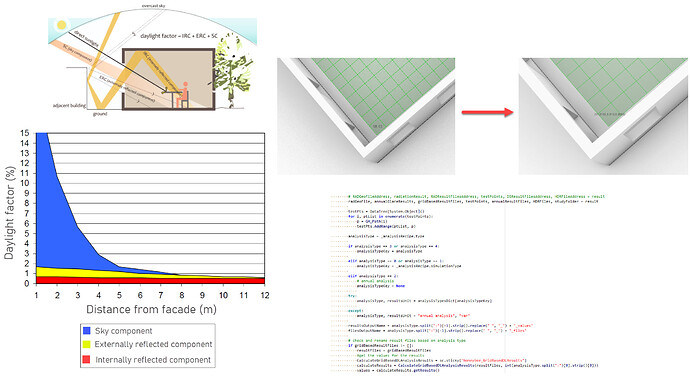Hi.
I’m wondering if it’s possible to export out the different components, that gives us the DF_values e.g. in a daylight factor calculation. The values should be available, but maybe hidden away in a imported script in the LB daylight calculation Py.-component?
It would be nice to be able to export the different components e.g. as shown in the picture below (just an illustration).
@mostapha have you looked into this before?
It’s possible to get each component but this is not how DF is being calculated in Honeybee (or any other Radiance-based tools out there). The way honeybee calculates the daylight factor is by dividing the illuminance value at every sensor by the expected illuminance value from the sky for an unobstructed sensor. If the illuminance outside is 100,000 lux and you get 100 lux daylight factor is 100 / 100,000. This single value includes all the 3 components.
If you want to get each component separately you can but you have to run 3 separate daylight factor simulations.
-
Set all the opaque material to black and run the daylight factor simulation. This will give you only the sky component since there will be no reflected addition.
-
Keep the interior faces as black but set the exterior ones to what they need to be and re-run it. This will be sky component + externally reflected component. Subtract the sky component which you calculated in 1 and you will get the externally reflected component.
-
Run the daylight factor simulation with all the normal materials which give you all the 3 components together. Subtract the results from step 2 from this step and that will give you the internally reflected component.
Make sure that you put a geometry in your model for the ground to remove the effects of the ground hemisphere which is part of the sky definition.
Out of curiosity why are you still using daylight factor and trying to get into this level of details? Is it possible to use the annual climate-based simulations instead? Is it because you are trying to model for some code compliance somewhere?
Hi @mostapha
Thank you for a quick reply.
I’ve tried the solution with three different simulations. That is a solution, but I was hoping it was a better way to get the three different values, by exporting it as a result from the Rad. calculation or something.
As for why: E.g. illustrating how the reflections in a room decreases, as a function of the depth in the room.
Out of curiosity: If I have understood how LB/HB work “under the hood” in terms of utilizing Radiance, you bring the ill.files into Grasshopper after a Radiance simulation.
So I guess my question, more precisely put, is:
Is it a way to “export” the three different values from Radiance, in stead of just exporting the total (SC+ER+IR)?
Why we’re looking into average daylight factor (Daylight Factor Simulations):
In Scandinacia (Norway, Sweeden and Finland) we still have a building code where the demand for daylight are e.g. minimum 2.0 % in average daylight factor over the task area (not quite sure about Finland though). In Denmark they’ve implemented a possibility meet the daylight requirements by simulating DA.
